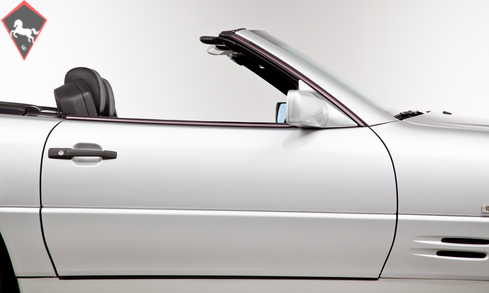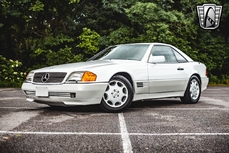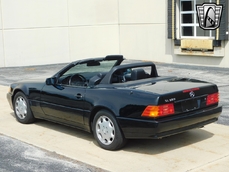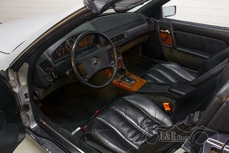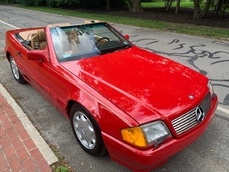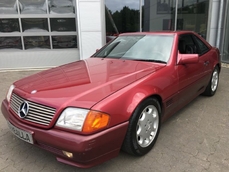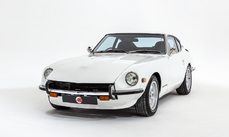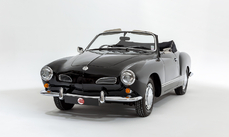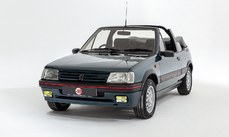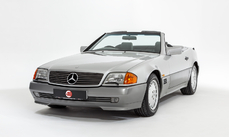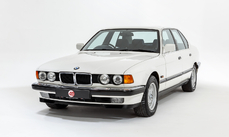Mercedes-Benz 300SL r129 SL 500 1996
General description :
A well-maintained facelift SL 500, AMG split rims, Bose, and just 69k miles.
MODEL HISTORY
Designed and built as a grand tourer the SL was first introduced in 1954. The designation SL derives from the German for ‘Sport Lightweight' and was first applied to the 300 SL Gullwing. The SL model range is still in production today and has spanned five generations of models from 1954 to the present day.
The R129 as featured here is the fourth generation of car and was built from 1989-2002. Featuring a shorter wheelbase and updated rear suspension over its predecessor the R107. The R129 was quick to introduce model updates and featured a large amount of styling, mechanical and technological updates over its 12-year life span.
The R129 shot to the public's attention in 1991 when Diana, Princess of Wales, sold her Jaguar to purchase a 500 SL. This sparked a media storm, as this was the first time a member of the royal family had chosen a foreign car. The media questioned whether British royalty should be driving foreign cars and eventually due to pressure she was forced to return the car to Mercedes-Benz in 1992. The car now features in the Mercedes-Benz Museum.
Equipment
Brilliant Silver Metallic (744), Black leather upholstery (261), Electrically adjustable front seats with memory function (241/242), Cruise control, Self-dimming rear-view mirror (249), Electrically adjustable door mirrors with memory function (501), Electrically adjustable steering wheel, Digital climate control, Paint protection (524), Xenon headlamps, Headlamp cleaning (600), Electric folding soft-top in black (740), Removable hard top in Brilliant Silver, Model year 1996 (806), Bose sound system (810), Heated front seats (873), Mercedes radio/cassette, Mercedes velour overmats, 8-Hole alloy spare wheel, Warning triangle.
EXTERIOR
The sleek silver paintwork extends to the lower panels, bumpers, and removable hardtop. The car presents in very good condition throughout with few imperfections to note. There are no scuffs or scrapes to be found and almost no chips to the front end. All the lenses are clear and crack-free and there is no evidence of any corrosion at all. As a facelift example the car features a handful of aesthetic changes over earlier R129s, but does still retain the original style rear light clusters.
INTERIOR
The classic R129 interior boasts the later style steering wheel and seats, both upholstered in supple black leather. The seats are fully electric and are equipped with memory functions for both driver and passenger. They are also heated, which is perfect for those crisp mornings with the roof down.
The cabin presents extremely well throughout. There is no cracking or sun damage to any of the lustrous walnut veneer, and all the switchgear remains feeling solid to operate. The steering wheel and leather gear selector are in fine condition as well. The carpets are free from any wear or discolouration and are protected in the footwells and behind the seats by a set of Mercedes overmats. The load compartment is also impeccably clean.
ENGINE & TRANSMISSION
As a 1996 Model Year car this SL is equipped with a five-speed electronic automatic transmission, as opposed to the four-speed hydraulic setup on previous variants. On first turn of the key the car idles up to temperature nicely, and pulls strongly through each of the gears on test. The 5-litre V8 was last serviced 6,700 miles ago, but will receive a fresh oil change upon sale for the new keeper's peace of mind.
WHEELS, TYRES & BRAKES
The arches are filled with a set of 18-inch two-piece AMG alloys. The wheels are very presentable with only minor age-related wear to the polished rims, however a perfectionist may choose to refurbish. They are shod in high quality tyres front and rear, each with ample tread remaining. Beneath the boot floor you'll find a full size spare wheel in the standard 8-hole design.
HISTORY FILE
The SL was first registered on 16th February 1996 and was supplied new by Yanase Mercedes-Benz. Present in the history file you'll find the original leather document holder complete with all the dealer-supplied manuals. The Mercedes service booklet is also present, and the maintenance history is recorded at the following intervals:
2,101km / 1,306 miles14,283km / 8,875 miles24,702km / 15,359 miles30,518km / 18,963 miles41,876km / 26,020 miles53,872km / 33,475 miles80,687km / 50,137 miles89,669km / 55,718 miles93,573km / 58,144 miles98,188km / 61,011 miles101,805km / 63,259 miles
http://www.4starclassics.com/mercedes-r129-sl-500-for-sale-2/
1996 Mercedes-Benz 300SL r129 SL 500 is listed sold on ClassicDigest in Kingsley by 4 Star Classics for £14995.
Car Facts
Car type : Car Make : Mercedes-Benz Model : 300SL r129 Model Version : SL 500 Engine size : 5.0 Model Year : 1996 Sub type : Coupé Location : Hampshire
Sold
Seller Information
Sold
People who viewed this Mercedes-Benz 300SL r129 also viewed similar Mercedes-Benz listed at ClassicDigest
Other cars listed for sale by this dealer
About Mercedes-Benz
In the annals of automotive history, the journey of Mercedes-Benz is a tale that unfolds with the ingenuity of its founding pioneers. In the year 1886, Karl Benz crafted the Benz Patent Motorwagen, a creation that would go down in history as the world's inaugural automobile. Unbeknownst to him, this moment marked the genesis of what would evolve into the most illustrious premium car manufacturer globally. The financial underpinning of this pioneering venture, interestingly, was provided by Karl Benz's wife, Bertha Benz, demonstrating a remarkable partnership that would set the tone for Mercedes-Benz's legacy.A parallel narrative emerged not far away, as Daimler-Motoren-Gesellschaft, founded by Gottlieb Daimler and Wilhelm Maybach, entered the scene. In 1901, they unveiled their automobile under the now-famous moniker "Mercedes," meaning "godsend" in Spanish. This name was bestowed upon the car at the behest of Emil Jellinek's daughter, the distributor for Daimler-Motoren-Gesellschaft. The wheels of innovation were set in motion.
Fast forward to 1926, a pivotal year that witnessed the merger of Daimler with Benz & Cie., culminating in the birth of Daimler-Benz. The amalgamation saw the adoption of "Mercedes-Benz" as the distinguished trademark for their automobiles, fusing the legacies of two visionary entities into one.
Contrary to perceptions of conservatism, the trajectory of Daimler-Benz unfolds as a chronicle of industry firsts. From the introduction of the honeycomb radiator to the float carburetor, and the pioneering implementation of four-wheel brakes in 1924, Daimler-Benz consistently pushed the boundaries of automotive innovation. The diesel-powered Mercedes-Benz 260 D in 1936 marked the inception of diesel engines in passenger cars. The iconic Mercedes-Benz 300SL Gullwing made history as the first car with direct fuel injection, albeit the Gutbrod's tiny 2-stroke engine can claim precedence.
Safety innovations became a hallmark, with Béla Barényi's patented safety cell design in the "Ponton"-models in 1951, featuring front and rear crumple zones. The W116 450SEL 6.9 saw the introduction of the Anti-Lock Brake system (ABS), another pioneering safety feature. From the first production airbags and beyond, the legacy of "firsts" continued to be etched into the fabric of Daimler-Benz.
Over its centennial journey, Mercedes-Benz has not merely produced cars but has sculpted automotive icons. The SSKL, 710 SSK Trossi Roadster, 770K Grosser, 540K Spezial Roadster, 300SL Gullwing, w100 600 Pullman, w111 280SE 3.5 Flachkühler, w113 230SL Pagoda, w109 300 SEL 6.3, and w201 2.3-16 Cosworth stand testament to the brand's commitment to engineering excellence.
The roaring Silver Arrows, or "Silberpfeile," including the W 25, W 125, W154, W165, and W196, created a legacy of dominance on the racetrack. These machines were not merely cars; they were expressions of precision, speed, and an indomitable spirit that left their competitors in the dust.
As Mercedes-Benz marches into the future, it does so not just as an automaker but as a custodian of a legacy, a torchbearer of innovation, and a beacon of automotive excellence. The road ahead is sure to witness the continued fusion of cutting-edge technology, timeless design, and an unwavering commitment to setting new standards in the world of automobiles.
One luminary figure who left an indelible mark was Béla Barényi, often heralded as the "father of passive safety" for his pioneering work in safety engineering. His patented safety cell design, featuring front and rear crumple zones, became a hallmark of Mercedes-Benz's commitment to occupant safety, setting new standards that reverberated throughout the automotive world.
Moving through the chronicles, the collaborative genius of Wilhelm Maybach, alongside Gottlieb Daimler, laid the foundation for Daimler-Motoren-Gesellschaft. Their innovations not only birthed the first Mercedes but established a culture of relentless pursuit of technological excellence that remains integral to Mercedes-Benz's DNA.
In the post-merger era of 1926, Ferdinand Porsche emerged as a prominent figure within Mercedes-Benz. His work on the Mercedes-Benz S-Type, a supercharged race car, garnered acclaim and set the stage for a legacy that extended far beyond the marque. Porsche's impact would later extend to his eponymous company, but his influence at Mercedes-Benz during those formative years was pivotal.
As the 20th century progressed, the legendary Rudolf Uhlenhaut emerged as a key figure. Uhlenhaut, an accomplished engineer and the driving force behind the iconic Silver Arrows, played a crucial role in Mercedes-Benz's dominance in motorsports. His engineering prowess and attention to detail were instrumental in creating some of the most formidable racing cars of the era.
In the latter half of the century, figures like Bruno Sacco, the head of design at Mercedes-Benz from 1975 to 1999, left an indelible imprint on the brand's aesthetic identity. Sacco's design philosophy, characterized by clean lines and timeless elegance, shaped iconic models like the W126 S-Class and the W201 190E, solidifying Mercedes-Benz's reputation for luxury and sophistication.
The narrative would be incomplete without acknowledging the contributions of engineers like Hans Scherenberg, whose leadership in the 1970s ushered in a new era of technological innovation at Mercedes-Benz. Scherenberg's tenure saw the development of groundbreaking technologies, including the Anti-Lock Brake system (ABS) and the introduction of airbags in production cars.
